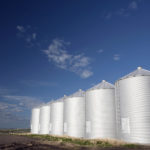Reading Time: 2 minutes MarketsFarm — With a significant amount of corn still in the fields on the U.S. northern Plains, the harvest may be grinding to a halt, according to MarketsFarm analyst Bruce Burnett. In particular, Burnett noted, the corn harvest has been further slowed by a propane shortage, which has caused issues for farmers trying to acquire […] Read more

Corn harvest a struggle for three U.S. states

Scramble for propane marks Mother Nature’s latest challenge for U.S. farmers
Reading Time: 3 minutes Chicago | Reuters – Months after historic floods ravaged the U.S. Midwest, farmers scrambling to harvest their crops face a new headache: finding fuel to dry their soaked grains. Normally, farmers use propane as fuel for grain dryers to reduce moisture levels in corn crops to ready for sale or to safely store the grain. But the […] Read more

Keeping your stored grain cool and dry
With increased storage depth comes increased risk. Are we moving enough air through today’s larger grain bins?
Reading Time: 5 minutes For anyone visiting the rural Prairies for the first time in a few years, one of the first things they might notice is that those are not their dad’s grain bins — 20,000- to 50,000-bushel bins are now a common sight. But bigger bins mean bigger challenges in managing moisture, and bigger losses if things […] Read more

Do you know how your aeration fan blows?
Understanding different fan types, and the difference between moving air versus moving water, will help you keep those ever-larger bins of canola in top condition
Reading Time: 7 minutes To cool a bin of canola, the aeration fan needs to move 0.1 to 0.2 cubic feet of air per bushel per minute. To remove moisture, airflow should be about 10 times that. Does your fan achieve those rates? How do you know? A five-horsepower axial fan can blow more air per minute than a […] Read more

Follow storage guidelines to protect your pulses
Combining pulses when they’re tough reduces damage to seeds, but they then need to be dried down
Reading Time: 4 minutes Pulse crops retain their quality and maximize their marketability when a few grain storage guidelines are followed. Downgrading of pulses can occur when cracked seed coats or split seeds are present in the sample, or if a significant amount of seeds are heated or have a musty odour. The Canadian Grain Commission’s dry seed moisture […] Read more

Is stored canola at bigger risk than ever?
Huge bins, straight combining and delivery contracts for June and July have all potentially increased the storage risk for canola. But the basics for safe storage — eight per cent moisture, 15 C or less and regular monitoring — still apply
Reading Time: 4 minutes We don’t really know whether canola in a 25,000-bushel bin stores differently from canola in a 2,000-bushel bin. We don’t know if straight combining reduces or increases canola storage risk. And we don’t know the best way to store canola for 11 months through fall, winter, spring and summer weather changes. Given that many canola […] Read more

Grain analyzer gets attention
Soybean Guide: With more soybeans and corn stored on farm, this new analyzer is paying off
Reading Time: 5 minutes It’s easy to see why grain analyzers and testers are garnering more attention in ag circles, from the farm all the way up through elevators and even at large-scale processors. With tighter margins and a greater focus on finding efficiencies, but also with more focus on traceability, more interest in new traits, and more markets […] Read more


